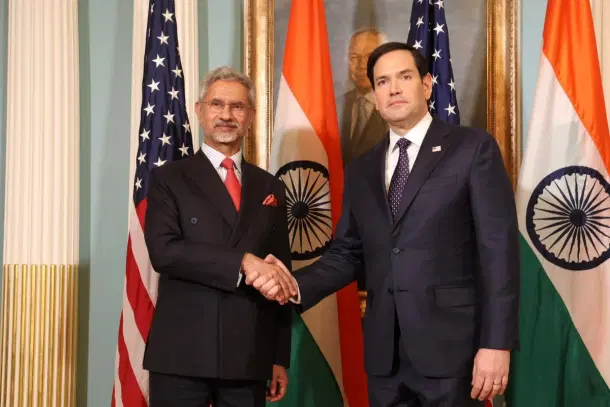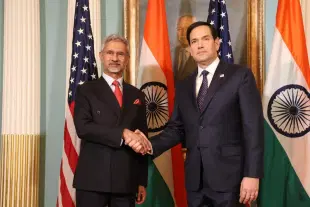World
Everything Wrong About US Communication On The ‘Ceasefire’
Arush Tandon
May 11, 2025, 01:06 PM | Updated May 16, 2025, 01:37 PM IST
Save & read from anywhere!
Bookmark stories for easy access on any device or the Swarajya app.


India and Pakistan ‘agreed’ to cease further hostilities, yesterday, 10 May. While the Pakistan Foreign Minister termed it a ‘ceasefire’, Indian foreign minister S Jaishankar called it a ‘stoppage of firing and military action’.
What came as a surprise to observers in this flow of events however was the fact that this decision to cease hostilities was informed to the public not by authorities of India or Pakistan but by US President Donald Trump. And following Trump’s post on X, the news was shared with apparent gusto by his Cabinet colleagues, Vice President JD Vance and Secretary of State and National Security Advisor, Marco Rubio.
This was followed the next day, 11 May, by Trump’s post on ‘Truth Social’ where he commends ‘the leadership of India and Pakistan’ and also mentions a ‘solution’ regarding Kashmir.
"I am very proud of the strong and unwaveringly powerful leadership of India and Pakistan for having the strength, wisdom, and fortitude to fully know and understand that it was time to stop the current aggression that could have lead to to the death and destruction of so many,⦠pic.twitter.com/ySS1UAR3QM
— Press Trust of India (@PTI_News) May 11, 2025
Consistent in all US leadership communication were two jarring notes:
1. A false equivalence between India and Pakistan
2. Trump appearing non-serious
India-Pakistan is not a conflict between equals
‘Congratulations to both countries using common sense and intelligence’, said Trump. Rubio went one step further: “I am pleased to announce the Governments of India and Pakistan have agreed to an immediate ceasefire and to start talks on a broad set of issues at a neutral site.” (Journalists later quoted Government of India sources to say that India didn’t agree to any talks).
Both these posts hyphenate India and Pakistan. To a reader who has no prior knowledge of the Indian subcontinent, both these posts would imply that India and Pakistan are engaged in a conventional military conflict.
In reality, even the most dispassionate analyses cannot deny that the conflict is between a terror conglomerate and a modern nation-state.
Those who executed the Parliament attack of 2001 were not Pakistan army regulars but jihadi terrorists. Same for 26/11. Uri. Pulwama. Reasi. Pahalgam.
Pakistan uses terrorists to attack India and India repels these with its regular security forces. Pakistan carries out inhumane atrocities on terror victims and then gives the excuse of ‘non-state actors’ whereas Indian response has to always be within international conventions and protocols.
Since after the 1971 war, the conflict between the two countries has not been conventional.
To explain using a recent example, the conflict is like Israel’s war with Hamas. A modern nation-state is locked in battle with a medieval terror group which possesses advanced weapons. The US leadership however is treating the situation similar to the Russia-Ukraine conflict or how they would treat a conflict between North and South Korea.
Let’s go back to Rubio’s post: “. . .India and Pakistan have agreed to an immediate ceasefire and to start talks on a broad set of issues at a neutral site.” What the US establishment does not understand, or ignores, is that there are no ‘broad set of issues’ between India and Pakistan unless Pakistan continues to export terror to India. Till such a time, terror is the only issue.
At the risk of repetition, Rubio’s post treats this as a conventional conflict when it is anything but.
Non-serious POTUS
President Trump’s post on Truth Social makes for jarring reading. “While not even discussed, I am going to increase trade, substantially, with both of these great Nations”. While such statements are expected with the current US president, the patronising tone of it cannot still be ignored.
India was seeking to punish Pakistan for massacring Indians in front of their families. That was what Operation Sindoor was about. To introduce ‘trade’ into the discussion, and publicly at that, sends a message that the US president is not as serious about loss of Indian lives as he ought to be.
But Trump’s post gets worse. “Additionally, I will work with you both to see if, after a “thousand years,” a solution can be arrived at concerning Kashmir.”
This sentence is likely to work in favour of Pakistan as Islamabad has always stressed on Kashmir being an international issue. India’s long-standing view, meanwhile, has been that Kashmir is a bilateral issue only and in that, the only issue to resolve is Pakistan’s illegal occupation of parts of Jammu and Kashmir. There is no room for any third-party mediation in it as far as New Delhi is concerned.
At the time of writing, India’s official response to Trump’s latest post was not known. But Trump, with his post about ‘working to arrive at a solution’ for Kashmir, has toed the Pakistan line on the issue.
What line Pakistan will now take is an easy guess.
See you in the next round.
Arush Tandon is interested in icons of history, history of independent India and, Indian culture.





